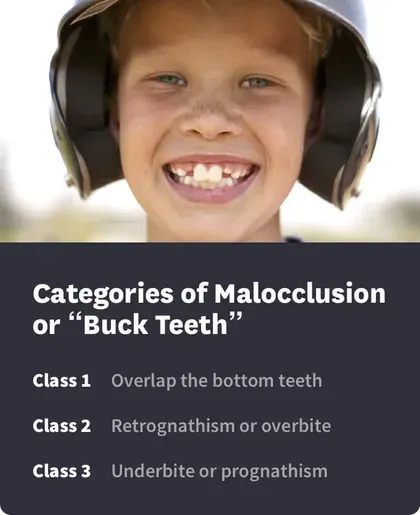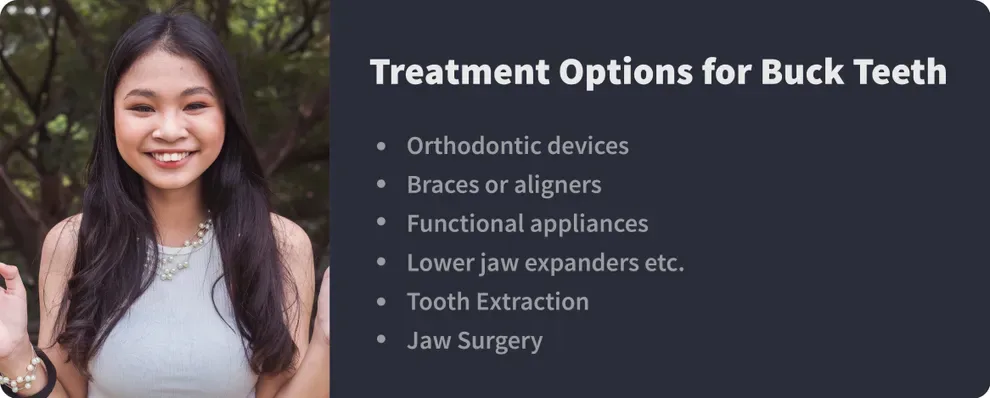Why Getting Rid of 'Buck Teeth' Is Easier Than You Thought

Table of Contents
- What are Buck Teeth?
- Causes
- Easier to Fix Than You Thought
- Treatment Options
- Fixing Buck Teeth
- Buck Teeth Risks
Buck teeth is a term used for an overbite. This is a type of malocclusion (teeth misalignment) in which the upper front teeth protrude over the lower front teeth.
Overbites are often caused by genetics, but they can also be related to childhood habits like thumb sucking or pacifier use.
Overbites are very common, and very minor overbites may not require treatment. More prominent overbites, however, can impact your appearance as well as your oral and overall health.
While major overbites may require braces, orthodontic appliances, or even surgery, those with minor to moderate overbites or “buck teeth” may be candidates for clear aligner treatment, which is a much more convenient and affordable treatment option.
What are Buck Teeth?
Buck teeth refers to the look of teeth with an overbite. It is a condition in which the upper front teeth sit too far in front of the lower front teeth.
Note that with a properly aligned natural bite, the upper teeth do sit comfortably on the lower front teeth. An overbite is present when there is too much of an overlap of the upper teeth over the lower.
Buck teeth is a term most used to describe noticeable cases of overbite. The upper front teeth may also appear to be protruding outward. Buck teeth are also called overjet teeth.
Causes of Buck Teeth
Most of the time, buck teeth are hereditary. If your parents had buck teeth, you are more likely to have them yourself.
Besides genetics, some habits can cause buck teeth. You might have buck teeth if you:
Sucked your thumb: While many babies and young toddlers suck their thumbs, the practice can cause problems, including buck teeth, if it continues beyond age 3 or so.
Used a pacifier: Some parents encourage their toddlers to use pacifiers, thinking that they can avoid the buck teeth associated with thumb sucking. Unfortunately, pacifier use can also cause buck teeth. While there are some brands of pacifiers that claim to be “orthodontic pacifiers,” any pacifier use should be discouraged beyond age 3.
Have alignment issues: Whether you have crowded teeth or impacted teeth, these alignment issues can sometimes create buck teeth.
Are missing teeth: Similarly, missing teeth can cause teeth to shift over time, contributing to buck teeth.
Have a tongue thrust: This means that your tongue pushes against your front teeth too much, often every time you swallow. Since the tongue is so strong, it can gradually push the teeth forward over time, resulting in an open bite and even buck teeth.
Buck Teeth: Easier to Fix than you Thought
Prominent front teeth, or buck teeth, may appear in childhood. They are often corrected with a course of braces in the early teenage years.
In some cases, the shape of your jaw, genetic potential, and lifestyle habits like tongue thrusting may make buck teeth appear later in life. As more adults pursue orthodontic treatment to improve their smiles, more people are seeking treatment for buck teeth.
You may feel self-conscious about your buck teeth and wonder if it is even possible to fix them. The good news is that you can treat malocclusions like these. Some overbites require braces, but many people can easily fix this issue with just a few months of clear aligners.
You can absolutely fix buck teeth in adulthood. Many treatment approaches are simple and fast. First, you need to determine the severity of your malocclusion. An orthodontist can evaluate this in person, or an aligner company will assess your impressions to diagnose the severity.
There are three categories of malocclusion.

Class 1: This is the most common form of misalignment. The person has a normal bite, but the upper teeth somewhat overlap the bottom teeth. This may still create the appearance of buck teeth.
Class 2: This is also called retrognathism or overbite. It happens when the upper jaw and teeth seriously overlap the lower ones.
Class 3: Typically called an underbite or prognathism, this is when the lower jaw and teeth jut forward and overlap the upper jaw and teeth.
If you have a serious malocclusion like buck teeth or an overbite, you may have a hard time biting and chewing. You may have trouble properly cleaning your teeth, and you may even have an abnormal appearance to your face.
Even people with mild cases of buck teeth often feel very self-conscious with this slight misalignment. Thankfully, there are various treatments that can correct an overbite with relative ease.
Buck teeth can make you feel self-conscious, but they can be easily corrected with a variety of devices and treatments, like clear aligners or functional appliances.
Treating Buck Teeth

Treatment for buck teeth and teeth misalignment is available at any age. Which types of treatment are available to you will depend on how severe your buck teeth are as well as other factors, like your overall oral health and whether or not you have any skeletal jaw issues.
Common treatments for buck teeth (overbite) include the following.
| Cost | Length of Treatment | Typical Use |
Aligners | $2,000 | 4 months | Mild to moderate cases of buck teeth |
Braces | $5,000 | 2 years | Significant cases of buck teeth that are accompanied by other forms of misalignment |
Appliances | $1,000 and up | 1 year | Young people with still-growing palates |
Tooth extraction | $75 to $200 per tooth | 1 day + recovery | Buck teeth caused by severe crowding that can’t be corrected with appliances alone |
Jaw surgery | Up to $40,000 for people without insurance | 1 day + recovery | Severe cases that can’t be corrected with orthodontic care alone |
If your overbite is caused (even in part) by skeletal or structural jaw issues—such as a protruding upper jaw or trauma from a jaw injury—you may need jaw surgery to correct the problem. Models and x-rays of your teeth and jaw may show that surgery will shift your jaw into correct alignment, allowing your bones to grow together properly. You are likely to need 12 to 18 months of braces prior to this surgery.
While many people go back to work within 10 to 14 days after surgery, significant swelling is common. It can take three weeks for the puffiness to go down, and eating can be difficult when your mouth is so sore. The incision and cut bones can also be very uncomfortable, so chewing is tough.
Jaw surgery can be very helpful for people with severe cases of misalignment. However, researchers warn that people should consider all other treatment options first. This surgery can change the way you look, and the recovery time is long. It’s not the right choice for all cases of buck teeth.
Sometimes, back teeth crowd front teeth to the point that they cannot be shifted. Your orthodontist may decide that removing these teeth and shifting the remaining ones back is the best process for correcting an overbite or buck teeth. Tooth removal may be completed before treatment with braces or aligners.
Dental appliances like a lower jaw expander (also called a palatal expander) can be used to guide jaw shifting and development. These are sometimes removable and sometimes fixed and applied by a dentist. Mouth guards may also be used on a temporary basis to prevent tooth or gum damage caused by misalignment.
Braces have long been the most popular approach to treating any malocclusion, including jaw alignment issues like overbites and related visible problems like buck teeth. With braces, brackets are cemented to the front of your teeth and bands are placed over the teeth. Wires connect the teeth and are tightened on a regular basis to apply continuous pressure and move teeth into position.
For serious overbites, braces may be required and used along with appliances and/or surgery. Braces treatment for severe overbites may take two years or longer.
Clear aligners are removable, and they fit over your teeth. With treatment, a series of aligners is created that gradually move your teeth into their optimal positions. You’ll wear one set of aligners for a week or two before moving on to the next one. After your last tray is complete, your teeth will be in alignment.
In some cases, in-office clear aligners may be used to treat more serious cases of overbite, often with orthodontic appliances. For mild or moderate cases of buck teeth and overbite, many may choose at-home clear aligners because of their convenience and fast results.
Fixing Buck Teeth Does Not Have to Take Years
Each treatment for overbite or buck teeth takes a different amount of time. Depending on your underlying medical needs, you could have a long-term plan spanning about two years.
For example, braces, surgery, and other appliances in combination can take several months or even years each. But if your malocclusion is serious enough that your oral health is at risk, spending the time on this process is important.
Some people benefit from using clear aligners to treat buck teeth. If your problem is mild, more cosmetic, and causes few health issues, you can get a series of doctor-monitored, at-home aligners. These aligners push teeth into place much like braces, but they can work faster and look better. Sometimes, clear aligners are called invisible braces because they are not noticeable.
In some cases, clear aligners may be recommended after jaw surgery, tooth extraction, or a shorter course of treatment with braces.
To determine if aligners can get rid of your buck teeth, you’ll need to take at-home impressions of your teeth. You’ll then mail those to the aligner company, and a doctor will assess whether aligners can work for you.
If you learn your case is too severe for aligner treatment, visit an orthodontist to determine what will work best for your situation.
Do not attempt to fix your buck teeth at home. Moving buck teeth back into alignment requires professional assistance and equipment. If you attempt to do any of this work at home on your own, you are likely to cause serious damage to your mouth and teeth.
While there are plenty of ways to treat buck teeth, many people opt to simply live with them. If you do, there are certain steps you can take to protect your oral health and mitigate issues related to buck teeth.
See your dentist regularly. Make regular twice-yearly dental appointments to get full cleanings and assessments.
Brush and floss daily. Maintain good oral hygiene by brushing twice daily and flossing at least once per day.
Try to control your tongue. If you have a tongue thrust, try to keep the tip of your tongue on the roof of your mouth rather than on the back of your front teeth.
Wear a night guard. This can help to protect your teeth at night, particularly if you clench or grind while you sleep.
See your doctor. If you have any breathing or speech issues associated with your buck teeth, see your doctor for an assessment. There might be devices or exercises they recommend to help the issue.
Risks of Untreated Buck Teeth
A healthy mouth has teeth that fit together perfectly when your mouth is closed. While buck teeth can be unsightly, they can also lead to serious health consequences. Treating them could improve both the way you look and your overall oral health.
Consequences of untreated buck teeth can include the following:
Poor Dental Hygiene
Among people ages 12 to 19, more than half have had a cavity in at least one permanent tooth. Among people 20 and older, at least 90% have had at least one cavity. Dental disease like this can be prevented with appropriate oral care, such as brushing and flossing. Buck teeth can make cleaning tough.
Protruding teeth may have gaps that collect food or gum pockets that harbor disease. Buck teeth may also be tender and sore, leading people to avoid cleaning them properly.
Speech Impediment
Among children ages 3 to 17, 5% have a speech disorder that lasts a week or longer. Sometimes, these conditions are caused by things like illnesses or disease. Sometimes, they’re caused by tooth position.
Buck teeth force your tongue to come forward in your mouth when making hard consonant sounds. That added space can lead to speech delays or lisping. Sometimes, ill-fitting teeth can allow saliva to build up in your mouth, so you must swallow often while speaking.
Oral Injuries
Teeth that don’t fit together properly can click and clack together. Sometimes, that causes tiny cracks in the edges of teeth. In severe cases, teeth can splinter or crack into pieces.
Broken teeth are very sharp, and they can easily cut sensitive structures like the tongue and cheeks. Chipped teeth can also be very sensitive, and repairing them could be critical to prevent decay and more pain.
Breathing Issues
Researchers say there’s a close connection between breathing issues (like open-mouth breathing) and buck teeth. They’re so closely connected, in fact, that it’s hard to determine if the breathing causes the improper tooth placement or if the teeth cause the breathing issues.
Breathing issues like this can cause teasing, as it’s a habit people associate with low intelligence. However, people who breathe this way may also seem listless or inattentive, and that’s likely due to sleeping problems. It’s hard to get enough oxygen at night due to poor breathing habits.
Chewing Problems
When teeth don’t meet properly, it’s difficult to do things like take a clean bite of pizza. The teeth don’t come together like scissors, so it’s difficult to break off a piece of food into the mouth. People with a severe case of buck teeth may need to cut all types of food into small pieces with knives and forks, as they can’t use their teeth for this critical task.
